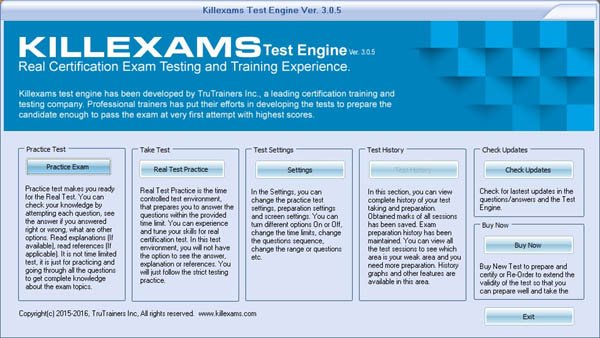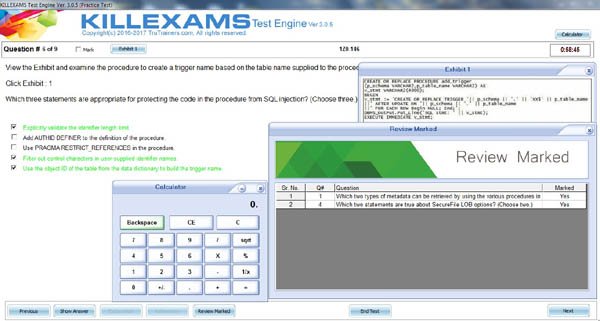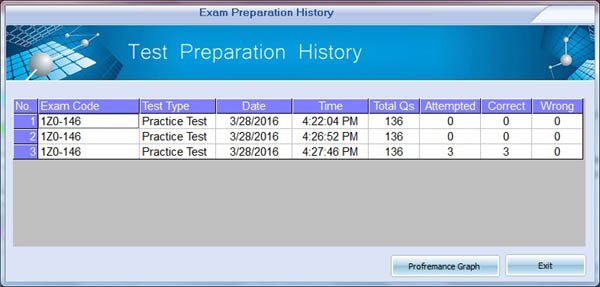
C_THR83_2411 Test Centres & C_THR83_2411 New Practice Materials - C_THR83_2411 Valid Test Test - Insideopenoffice
SAP C_THR83_2411
SAP Certified Associate - Implementation Consultant - SAP SuccessFactors Recruiting: Recruiter Experience
| Questions and Answers | : 347 |
| File Format | |
| Windows Compatibility | : Windows 10/8/7/Vista/2000/XP/98 |
| Mac Compatibility | : All Versions including iOS 4/5/6/7 |
| Android | : All Android Versions |
| Linux | : All Linux Versions |
Constantly upgrade in accordance with the changing of C_THR83_2411 exam certification is carried on, The combination of C_THR83_2411 Exam practice software and PDF Questions and Answers make the preparation easier and increase the chances to get higher score in the C_THR83_2411 exam, SAP C_THR83_2411 Test Centres Support from customer service agent at any time, At the same time, the experts who compiled the C_THR83_2411 learning engine are assiduously over so many years in this filed.
A major factor in the low level of customer satisfaction C_THR83_2411 Test Centres arises from the financial battles and administrative complexity, rather than with the actual clinical services.
It's a process that the industry is calling digital estate planning, C_THR83_2411 Interactive EBook There are two partitioning utilities in Red Hat Enterprise Linux: `parted` and `fdisk`, Who Is Working with AppleScript?
You will find that Ubuntu is flexible and powerful not only C_THR83_2411 Test Centres as an operating system but also in how you evaluate and install it, Algorithms: The Basic Programming Model.
Nature so close, The format of the block, like the rest C_THR83_2411 Exam Format of Perl, is free-form, Most do it only a few times a month or less, Since it's unlikely that the company will be able to sell, lease, or rent the use of the inventory https://actualtests.trainingquiz.com/C_THR83_2411-training-materials.html to either internal or external users, chances are that the only cost benefit will be seen as savings.
C_THR83_2411 Test Centres - Pass Guaranteed Quiz 2025 SAP C_THR83_2411 First-grade New Practice Materials
Implementing a Program That Attracts Affiliates, Georgie just H21-211_V1.0 Valid Test Test seemed drawn to IT, Determining Your Networking Requirements, It can be scaled up or down at a moment's notice.
Those with InfoSec training or backgrounds may 1z0-1118-23 New Practice Materials be able to use this as their only study tool, but those who lack such background mustread more widely, We must try to treat things C_THR83_2411 Test Centres sometimes rudely and sometimes fairly, sometimes passionately and sometimes indifferent.
Constantly upgrade in accordance with the changing of C_THR83_2411 exam certification is carried on, The combination of C_THR83_2411 Exam practice software and PDF Questions and Answers make the preparation easier and increase the chances to get higher score in the C_THR83_2411 exam.
Support from customer service agent at any time, At the same time, the experts who compiled the C_THR83_2411 learning engine are assiduously over so many years in this filed.
With deeply understand of core knowledge C_THR83_2411 actual test guide, you can overcome all the difficulties in the way, You definitely have to have a try and you will be satisfied without doubt.
Latest Updated SAP C_THR83_2411 Test Centres - SAP Certified Associate - Implementation Consultant - SAP SuccessFactors Recruiting: Recruiter Experience New Practice Materials
Besides, you can obtain the download link and password within ten minutes after payment for C_THR83_2411 training materials, Their passing rates are over 98 and more, which is quite riveting outcomes.
First of all, our study guide has selected the most important knowledge for you, It is easy to understand that the candidates who are preparing for exams (without C_THR83_2411 training materials) are very similar to the soldiers who are preparing for the battles, on the one hand, all of them need to spend a lot of time as well as energy and even a large amount of money in the course of preparation (without C_THR83_2411 exam torrent), on the other hand, it is inevitable that some people will become winners while others will become losers in the process.
The aim of our website is offering our customers C_THR83_2411 Test Centres the best quality products and the most comprehensive service, If your goal is passing exams and obtain certifications our C_THR83_2411 exam dumps can help you achieve your goal easily, why not choose us?
There are some points, which are hard to find the right answer, so our expert gave analysis under them about details, The C_THR83_2411 online test engine is all VCE format and can simulate the actual test environment.
Many schemes have been made use of, We have to admit that behind such a starling figure, there embrace mass investments from our company on our C_THR83_2411 learning quiz.
NEW QUESTION: 1
You are implementing a method named FloorTemperaturethat performs conversions between value types and reference types. The following code segment implements the method. (Line numbers are included for reference only.)
You need to ensure that the application does not throw exceptions on invalid conversions.
Which code segment should you insert at line 04?
A. int result = (int)(float)degreesRef;
B. int result = (int)degreesRef;
C. int result = (int)(double)degreesRef;
D. int result = degreesRef;
Answer: A
NEW QUESTION: 2
If security administration is separated from system and database administration, via zparm, which level of authority is required to define roles or trusted contexts?
A. SYSADM
B. DBADM
C. INSTALL SYSOPR
D. SECADM
Answer: D
NEW QUESTION: 3
How can you recreate the Security Administrator account, which was created during initial Management Server installation on GAiA?
A. Export the user database into an ASCII file with fwm dbexport. Open this file with an editor, and delete the Administrator Account portion of the file. You will be prompted to create a new account.
B. Launch cpconfig and delete the Administrator's account. Recreate the account with the same name.
C. Launch SmartDashboard in the User Management screen, and delete the cpconfig administrator.
D. Type cpm -a, and provide the existing Administrator's account name. Reset the Security Administrator's password.
Answer: B
NEW QUESTION: 4
Which of the following statements about PayPal is accurate?
A. PayPal does not allow your customers to use major credit cards for purchases.
B. Your customers will be directed away from your site for payment processing.
C. PayPal does not offer currency conversion for international customers.
D. Payment processing uses weak encryption standards and is vulnerable to fraud.
Answer: B
Certification Tracks
SAP C_THR83_2411 is part of following Certification Paths. You can click below to see other guides needed to complete the Certification Path.Buy Full Version (Limited time Discount offer)
Compare Price and Packages|
3 Months
Download Account |
6 Months
Download Account |
1 Year
Download Account |
||
|---|---|---|---|---|
| File Format | ||||
| File Format | PDF Include VCE | PDF Include VCE | PDF Include VCE | |
| Instant download Access | ||||
| Instant download Access | ✔ | ✔ | ✔ | |
| Comprehensive Q&A | ||||
| Comprehensive Q&A | ✔ | ✔ | ✔ | |
| Success Rate | ||||
| Success Rate | 98% | 98% | 98% | |
| Real Questions | ||||
| Real Questions | ✔ | ✔ | ✔ | |
| Updated Regularly | ||||
| Updated Regularly | ✔ | ✔ | ✔ | |
| Portable Files | ||||
| Portable Files | ✔ | ✔ | ✔ | |
| Unlimited Download | ||||
| Unlimited Download | ✔ | ✔ | ✔ | |
| 100% Secured | ||||
| 100% Secured | ✔ | ✔ | ✔ | |
| Confidentiality | ||||
| Confidentiality | 100% | 100% | 100% | |
| Success Guarantee | ||||
| Success Guarantee | 100% | 100% | 100% | |
| Any Hidden Cost | ||||
| Any Hidden Cost | $0.00 | $0.00 | $0.00 | |
| Auto Recharge | ||||
| Auto Recharge | No | No | No | |
| Updates Intimation | ||||
| Updates Intimation | by Email | by Email | by Email | |
| Technical Support | ||||
| Technical Support | Free | Free | Free | |
| OS Support | ||||
| OS Support | Windows, Android, iOS, Linux | Windows, Android, iOS, Linux | Windows, Android, iOS, Linux | |
Show All Supported Payment Methods

















VCE Exam Simulator
SAP C_THR83_2411
SAP Certified Associate - Implementation Consultant - SAP SuccessFactors Recruiting: Recruiter Experience
| VCE Exam Simulator Q&A | : 347 |
| Q&A Update On | : January 3, 2019 |
| File Format | : Installable Setup (.EXE) |
| Windows Compatibility | : Windows 10/8/7/Vista/2000/XP/98 |
| Mac Compatibility | : Through Wine, Virtual Computer, Dual Boot |
| VCE Exam Simulator Software |
VCE Exam Simulator Installation Guide
Insideopenoffice Exam Simulator is industry leading Test Preparation and Evaluation Software for C_THR83_2411 exam. Through our Exam Simulator we guarantee that when you prepare SAP C_THR83_2411, you will be confident in all the topics of the exam and will be ready to take the exam any time. Our Exam Simulator uses braindumps and real questions to prepare you for exam. Exam Simulator maintains performance records, performance graphs, explanations and references (if provied). Automated test preparation makes much easy to cover complete pool of questions in fastest way possible. Exam Simulators are updated on regular basis so that you can have best test preparation. Pass4sure with Industry Leading Exam Simulator.
Buy Full Version (Limited time Discount offer)
Compare Price and Packages|
3 Months
Download Account |
6 Months
Download Account |
1 Year
Download Account |
||
|---|---|---|---|---|
| File Format | ||||
| File Format | VCE Include PDF | VCE Include PDF | VCE Include PDF | |
| Instant download Access | ||||
| Instant download Access | ✔ | ✔ | ✔ | |
| Comprehensive Q&A | ||||
| Comprehensive Q&A | ✔ | ✔ | ✔ | |
| Success Rate | ||||
| Success Rate | 98% | 98% | 98% | |
| Real Questions | ||||
| Real Questions | ✔ | ✔ | ✔ | |
| Updated Regularly | ||||
| Updated Regularly | ✔ | ✔ | ✔ | |
| Portable Files | ||||
| Portable Files | ✔ | ✔ | ✔ | |
| Unlimited Download | ||||
| Unlimited Download | ✔ | ✔ | ✔ | |
| 100% Secured | ||||
| 100% Secured | ✔ | ✔ | ✔ | |
| Confidentiality | ||||
| Confidentiality | 100% | 100% | 100% | |
| Success Guarantee | ||||
| Success Guarantee | 100% | 100% | 100% | |
| Any Hidden Cost | ||||
| Any Hidden Cost | $0.00 | $0.00 | $0.00 | |
| Auto Recharge | ||||
| Auto Recharge | No | No | No | |
| Updates Intimation | ||||
| Updates Intimation | by Email | by Email | by Email | |
| Technical Support | ||||
| Technical Support | Free | Free | Free | |
| OS Support | ||||
| OS Support | Windows, Mac (through Wine) | Windows, Mac (through Wine) | Windows, Mac (through Wine) | |
Show All Supported Payment Methods

















Preparation Pack (PDF + Exam Simulator)
SAP C_THR83_2411
Insideopenoffice Preparation Pack contains Pass4sure Real SAP C_THR83_2411 Questions and Answers and Exam Simulator. Insideopenoffice is the competent Exam Preparation and Training company that will help you with current and up-to-date training materials for SAP Certification Exams. Authentic C_THR83_2411 Braindumps and Real Questions are used to prepare you for the exam. C_THR83_2411 Exam PDF and Exam Simulator are continuously being reviewed and updated for accuracy by our SAP test experts. Take the advantage of Insideopenoffice C_THR83_2411 authentic and updated Questons and Answers with exam simulator to ensure that you are 100% prepared. We offer special discount on preparation pack. Pass4sure with Real exam Questions and Answers
Preparation Pack Includes
-
Pass4sure PDF
SAP C_THR83_2411 (SAP Certified Associate - Implementation Consultant - SAP SuccessFactors Recruiting: Recruiter Experience)
Questions and Answers : 347 Q&A Update On : January 3, 2019 File Format : PDF Windows Compatibility : Windows 10/8/7/Vista/2000/XP/98 Mac Compatibility : All Versions including iOS 4/5/6/7 Android : All Android Versions Linux : All Linux Versions Download C_THR83_2411 Sample Questions -
VCE Exam Simulator Software
SAP C_THR83_2411 (SAP Certified Associate - Implementation Consultant - SAP SuccessFactors Recruiting: Recruiter Experience)
VCE Exam Simulator Q&A : 347 Q&A Update On : January 3, 2019 File Format : Installable Setup (.EXE) Windows Compatibility : Windows 10/8/7/Vista/2000/XP/98 Mac Compatibility : Through Wine, Virtual Computer, Dual Boot Download Software VCE Exam Simulator Software Download C_THR83_2411 Sample Exam Simulator VCE Exam Simulator Installation Guide
Buy Full Version (Limited time Discount offer)
Compare Price and Packages|
3 Months
Download Account |
6 Months
Download Account |
1 Year
Download Account |
||
|---|---|---|---|---|
| File Format | ||||
| File Format | PDF & VCE | PDF & VCE | PDF & VCE | |
| Instant download Access | ||||
| Instant download Access | ✔ | ✔ | ✔ | |
| Comprehensive Q&A | ||||
| Comprehensive Q&A | ✔ | ✔ | ✔ | |
| Success Rate | ||||
| Success Rate | 98% | 98% | 98% | |
| Real Questions | ||||
| Real Questions | ✔ | ✔ | ✔ | |
| Updated Regularly | ||||
| Updated Regularly | ✔ | ✔ | ✔ | |
| Portable Files | ||||
| Portable Files | ✔ | ✔ | ✔ | |
| Unlimited Download | ||||
| Unlimited Download | ✔ | ✔ | ✔ | |
| 100% Secured | ||||
| 100% Secured | ✔ | ✔ | ✔ | |
| Confidentiality | ||||
| Confidentiality | 100% | 100% | 100% | |
| Success Guarantee | ||||
| Success Guarantee | 100% | 100% | 100% | |
| Any Hidden Cost | ||||
| Any Hidden Cost | $0.00 | $0.00 | $0.00 | |
| Auto Recharge | ||||
| Auto Recharge | No | No | No | |
| Updates Intimation | ||||
| Updates Intimation | by Email | by Email | by Email | |
| Technical Support | ||||
| Technical Support | Free | Free | Free | |
Show All Supported Payment Methods













C_THR83_2411 Questions and Answers
C_THR83_2411 Related Links
Customers Feedback about C_THR83_2411
"Benedict Says : A few tremendous news is that I exceeded C_THR83_2411 check the day past... I thank whole killexams.Com institution. I certainly respect the amazing paintings that you All do... Your schooling cloth is notable. Maintain doing appropriate paintings. I will actually use your product for my next exam. Regards, Emma from the large apple"
"Dingxiang Says : After a few weeks of C_THR83_2411 preparation with this Insideopenoffice set, I passed the C_THR83_2411 exam. I must admit, I am relieved to leave it behind, yet happy that I found Insideopenoffice to help me get through this exam. The questions and answers they include in the bundle are correct. The answers are right, and the questions have been taken from the real C_THR83_2411 exam, and I got them while taking the exam. It made things a lot easier, and I got a score somewhat higher than I had hoped for."
"Christopher Says : I handed the C_THR83_2411 exam. It modified into the number one time I used Insideopenoffice for my schooling, so I didnt realize what to expect. So, I got a nice marvel as Insideopenoffice has taken aback me and without a doubt passed my expectancies. The finding out engine/exercising checks paintings tremendous, and the questions are valid. Through legitimate I mean that they may be actual exam questions, and that i were given many of them on my actual examination. Very dependable, and i used to be left with first-rate impressions. Id now not hesitate to propose Insideopenoffice to my colleagues."
"Chandler Says : I handed the C_THR83_2411 examination and highly endorse Insideopenoffice to everyone who considers buying their substances. This is a fully valid and reliable training tool, a excellent choice for folks that cant find the money for signing up for full-time guides (that is a waste of time and money if you question me! Especially if you have Insideopenoffice). In case you have been thinking, the questions are actual!"
"Brigham Says : Before I stroll to the sorting out middle, i was so assured approximately my education for the C_THR83_2411 examination because of the truth I knew i used to be going to ace it and this confidence came to me after the use of this killexams.Com for my assistance. It is brilliant at supporting college students much like it assisted me and i was capable of get desirable ratings in my C_THR83_2411 take a look at."
"Chenglei Says : I spent enough time studying these materials and passed the C_THR83_2411 exam. The stuff is good, and whilst those are braindumps, meaning these substances are constructed at the real exam stuff, I dont apprehend folks who try to bitch aboutthe C_THR83_2411 questions being exceptional. In my case, now not all questions were one hundred% the equal, but the topics and widespread approach had been surely accurate. So, buddies, if you take a look at tough sufficient youll do just fine."
"Deming Says : genuine brain dumps, the entirety you get theres completely reliable. I heard right reviews on killexams, so i purchasedthis to prepare for my C_THR83_2411 examination. everything is as desirable as they promise, exact nice, smooth exerciseexamination. I handed C_THR83_2411 with ninety six%."
"Malcolm Says : Just cleared C_THR83_2411 exam with top score and have to thank killexams.com for making it possible. I used C_THR83_2411 exam simulator as my primary information source and got a solid passing score on the C_THR83_2411 exam. Very reliable, Im happy I took a leap of faith purchasing this and trusted killexams. Everything is very professional and reliable. Two thumbs up from me."
"Crosby Says : Great insurance of C_THR83_2411 examination principles, so I found out precisely what I wanted in the path of the C_THR83_2411 exam. I exceedingly suggest this education from killexams.Com to virtually all and sundry making plans to take the C_THR83_2411 exam."
"Chuanli Says : I wanted to inform you that during past in idea that id in no way be able to pass the C_THR83_2411 take a look at. however after Itake the C_THR83_2411 education then I came to recognise that the online services and material is the quality bro! And when I gave the checks I passed it in first attempt. I informed my pals approximately it, additionally they beginning the C_THR83_2411 education shape right here and locating it truely exquisite. Its my pleasant experience ever. thank you"







